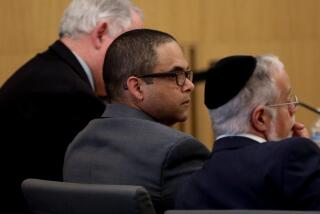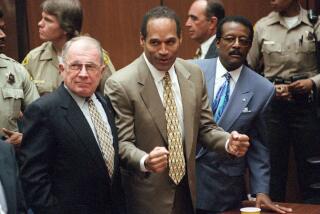NEWS ANALYSIS : Dizzying Pile of Evidence Could Back Either Verdict
As they begin their fifth day of deliberations, jurors in the Rodney G. King civil rights trial have a wealth of conflicting evidence to consider, giving them what analysts consider ample opportunity to support whatever verdicts they reach.
For starters, there is the testimony of 61 witnesses--including experts offered by both sides, many of whom contradicted each other. Then there are police reports, training bulletins, computer messages, fuzzy radio transmissions and the videotape of one of the defendants testifying, not in the federal trial but in state court last year.
And, at the core of it all, there is amateur photographer George Holliday’s videotape, both in its original form and in enhanced versions that stabilize the picture and attempt to reduce the blurriness.
All told, it is a potentially dizzying pile of information. Legal experts say jurors could find support for either guilty or not guilty verdicts against each of the four defendants--Stacey C. Koon, Laurence M. Powell, Timothy E. Wind and Theodore J. Briseno.
But those same analysts agree that the case is far stronger against Powell and Koon, who defended and took responsibility for what happened during King’s arrest, than against the other two.
“It’s a very close case,” said Laurie Levenson, a Loyola law school professor and former federal prosecutor. “It’s just impossible to tell for sure how the jury will go.”
The jury’s task is made all the more difficult by the starkly different versions of the incident that each side has presented: Was the King arrest a case of embattled cops grappling with a PCP-crazed ex-convict, or was it street justice callously dispensed by “bullies with badges,” in Justice Department attorney Barry F. Kowalski’s memorable phrase?
“There is no middle ground,” said Michael P. Stone, the attorney for Powell, who delivered the majority of baton blows to King.
To find any of the four men guilty, the jury has to find that the prosecution proved five things: that King was an inhabitant of California; that the defendant was acting under color of law; that the defendant deprived King of a right protected by the Constitution; that the defendant acted with specific intent to violate the law, and that the offense resulted in bodily injury.
There is no debate about the first two points, and the standard for proving bodily injury is easy to meet, according to several legal experts.
Determining whether the force used against King was excessive is the jurors’ first critical hurdle. If they decide excess force was used, they must turn to the issue of whether the officers who used that force did so intentionally.
The first question requires that the jurors stand in the shoes of a reasonable police officer “under the same circumstances, rather than with the perspective of perfect hindsight” in deciding how much force was justified to subdue King on that night in Lake View Terrace.
“The heart and guts of this case is what these 12 jurors think is reasonable for these police officers to have done,” said Levenson. “And that ultimately is a question of community standards, a question that these jurors are qualified to answer not because of any expertise but because of their life experience and their participation as members of this community.”
Along the same line, UCLA criminal law professor Peter Arenella said that the outcome of this issue may be influenced more by the personal philosophy of jurors than any piece of evidence.
“What constitutes a reasonable use of force requires a moral judgment by the community represented through the jury,” Arenella said. “And this case has revealed that within our community there are very different and very competing conceptions of what is considered an appropriate level of force in dealing with a suspect who has at least initially resisted lawful authority.”
In making this decision, the panelists are guided by one key jury instruction:
“You may consider the fact that police officers are often forced to make judgments, in circumstances that are tense, uncertain and rapidly evolving, about the amount of force that is necessary in a particular situation.”
Defense attorneys fought hard to get that language included in the instructions that U.S. District Judge John G. Davies gave jurors. Although he overruled the prosecution’s objections to the statement, the judge added a sentence reminding jurors that it is up to them to conclude whether the King arrest was made under “tense, uncertain and rapidly evolving” circumstances.
Arenella said the instruction’s balance lets jurors make their own decision.
“By focusing the jurors’ attention on tense, rapidly evolving situations, the instruction reminds the jury about one of the defense’s key themes--that cops have a tough, dirty job,” he said. “On the other hand, if this jury believes, using their own common sense, that the force used was excessive, then I don’t believe this instruction will stop them from finding that it was excessive force.”
Among the factors the jurors may consider is the LAPD’s policy that an officer should use only the force that is reasonable and necessary to overcome a suspect’s resistance. That standard determines whether the officers violated LAPD policy, not the Constitution, but it could help guide jurors in reaching their verdicts.
They also may take into account King’s demeanor, his large and muscular size and the wealth of conflicting testimony about whether he appeared to be under the influence of PCP.
And they may scrutinize the injuries King suffered, his apparent attempt to put his hands behind his back about a minute into the beating, Briseno’s videotaped testimony from the first trial saying he thought excessive force was used, and the fact that more than a dozen other officers stood around watching the beating.
If the jurors conclude that the force was excessive, they have to undertake perhaps an even more difficult task, legal experts say.
The jurors will need to put themselves inside the minds of each defendant and determine whether the officer’s action was done willfully, with the specific intent of violating the law.
Davies has called this “a high burden and a heavy burden.” Most analysts agree that the need to prove intent makes it harder for the federal prosecutors than it was for their state counterparts. The charges in state court did not include the same intent requirement.
On intent, the jurors will have to differentiate between Koon and the other defendants. Powell, Wind and Briseno are accused of Count 1--using excessive force against King. Sgt. Koon, the supervising officer, is charged with Count 2--failing to prevent the other officers from using excessive force against King.
The detailed jury instructions on this question says that intent can be proven by circumstantial evidence and tells jurors that they can infer that a person “ordinarily intends all the natural and probable consequences” of his acts.
Jurors do not have to find that a defendant was thinking of violating a specific provision of the Constitution or even was familiar with the Constitution. Perhaps most important, the instruction states that “the government may meet its burden even if a defendant was motivated by fear, anger or some other emotion.”
The government is not required to prove premeditation or that there was a conspiracy.
Among the factors that prosecutors say could be used to show intent are: the duration and character of the beating; Powell’s laughter at the scene; Powell’s computer transmission saying he had not beaten someone “this bad in a long time”; Powell’s telling war stories about the incident at the police station, and the various police reports filed by three defendants in which prosecutors say the seriousness of the beating was deliberately downplayed.
In addition, jurors may consider whether there are any significant inconsistencies between Koon’s testimony at this trial and last year’s state court trial.
Defense attorneys dispute all the evidence that prosecutors say shows intent to violate King’s rights. They say the officers’ only intent was to arrest a violently resisting suspect, not to harm him.
For example, Stone said that Powell’s apparent laughter, captured on a tape recording of a radio transmission of him requesting an ambulance, was merely a release of nervous tension, not evidence of callousness. As to the police reports, defense attorneys acknowledge that full details of the beating are not included but say that this was natural given the difficulty almost all people have in remembering violent incidents precisely.
In addition, some legal observers say that there is another aspect of this case that makes it difficult for the prosecution.
Barry Levin, a Los Angeles criminal defense lawyer and a former LAPD officer, said prosecutors must persuade jurors that the conduct of the officers became illegal quite rapidly, almost in “the blink of an eye.”
That is because both sides agree that the officers were initially entitled to use force against King. The issue, then, is not whether the entire beating was unreasonable, but rather whether a legal arrest at some point crossed the line.
That differentiates this trial from some prosecutions that have been brought under the statute used in this case--a law enacted in 1866 principally to deter attacks on blacks by the Ku Klux Klan in the aftermath of the Civil War.
In the King case, no one has alleged that the defendants “got together and said: ‘Let’s beat someone up tonight,’ ” Levin said. “The hallmark of the defense case is to portray these officers as just doing their jobs.”
Indeed, the officers arrived at the scene in response to police radio reports that California Highway Patrol officers were engaged in a high-speed chase. No one disputes that they were entitled to arrest King for violating the speed laws while legally drunk and for fleeing the officers who tried to pull him over.
If there are convictions, this would not be the first instance of a successful prosecution in a case where officers started out doing their jobs legitimately “but then crossed the line into illegal behavior,” Arenella said.
Among them is a 1975 case that began with a Macon, Ga., police officer arresting John V. Tucker on charges of being a “plain drunk.” Tucker, a field representative of an oil company on a business trip to Macon, was obstreperous and verbally abusive to police officers.
After Tucker was taken to the police station, Officer Charles C. Stokes shoved him down a flight of stairs, struck him with his hands and a nightstick and threw him against a wall head first, resulting in a fractured skull. Tucker was still in a coma when Stokes was convicted in federal court of violating his civil rights.
In 1991, four Oakland Housing Authority policemen were convicted of violating the civil rights of residents by engaging in excessive force while conducting drug investigations. One of those convicted was the supervising sergeant who condoned the practices.
More to Read
Sign up for Essential California
The most important California stories and recommendations in your inbox every morning.
You may occasionally receive promotional content from the Los Angeles Times.











